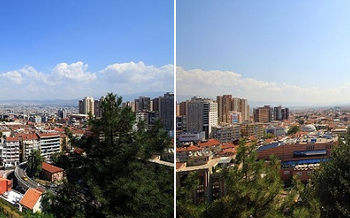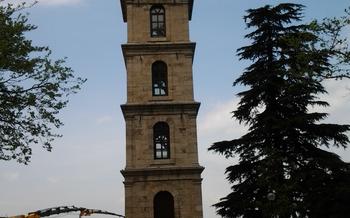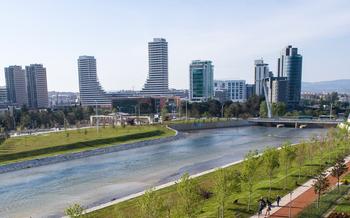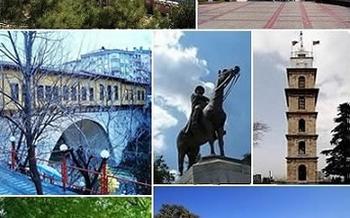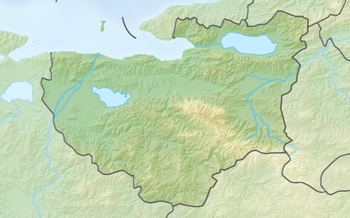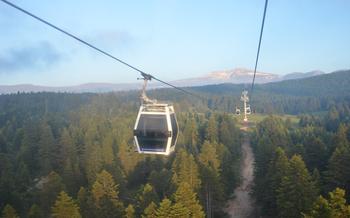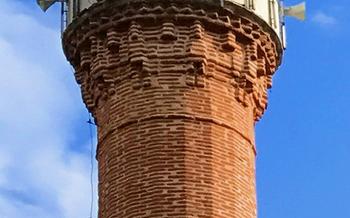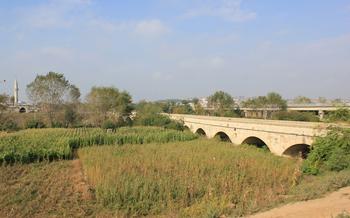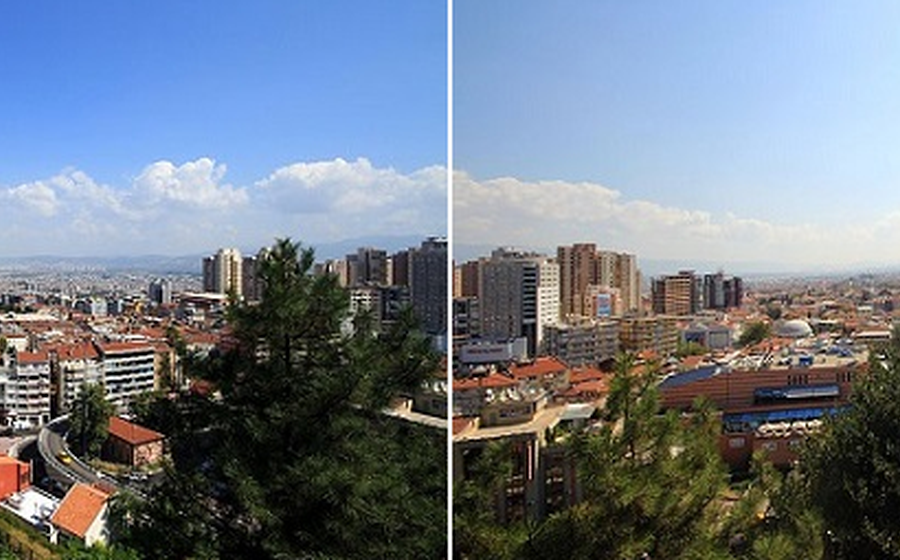
Mudanya Greek Orphanage
- Mudanya Greek Orphanage: A Historical and Cultural Landmark
- The Story of the Greek Orphans
- Exploring the Orphanage Grounds
- Volunteer Opportunities
- The Mudanya Armistice Museum
- The Mudanya Olive Oil Museum
- The Bursa Grand Mosque: A Majestic Symbol of Ottoman Architecture
- The Bursa Silk Market
- Uludağ National Park: A Haven for Nature Enthusiasts
- The İznik Tile and Ceramic Museum
- A Journey Through the Art of Ceramics
- The Bursa Archaeological Museum
- Insider Tip: Culinary Delights of Mudanya
Mudanya Greek Orphanage: A Historical and Cultural Landmark
The Mudanya Greek Orphanage stands as a testament to the complexities of history and the enduring legacy of human resilience. Built in the early 1920s, this imposing structure once served as a sanctuary for thousands of Greek orphans who fled the turmoil of the Greco-Turkish War. Its architectural grandeur, reflecting a blend of Ottoman and European influences, hints at the diverse cultural heritage that shaped this unique institution. Today, the orphanage has been lovingly restored and transformed into a museum, preserving the stories and memories of those who found refuge within its walls. Located in the heart of Mudanya, a charming coastal town just south of Istanbul, the orphanage is easily accessible and offers a glimpse into a poignant chapter of Turkish history.
The Story of the Greek Orphans
The influx of Greek refugees during the 1920s, following the Greco-Turkish War of 1919-1922, led to the establishment of the Mudanya Greek Orphanage. The orphanage served as a refuge for thousands of children who had lost their families and homes during the conflict.
The orphanage was founded in 1923 by a group of Greek Orthodox priests and philanthropists who were determined to provide a safe haven for the orphaned children. The orphanage initially operated in a small building in Mudanya, but as the number of orphans grew, it was relocated to a larger facility outside the city.
The orphanage provided the children with food, shelter, and education. The children attended school and received vocational training so that they could become self-sufficient and contribute to society. The orphanage also provided the children with a sense of community and belonging, helping them to heal from the trauma they had experienced.
The challenges faced by the orphans and staff of the orphanage were immense. The children had lost their families and homes, and many had witnessed unspeakable horrors during the war. The staff worked tirelessly to provide the children with the care and support they needed to rebuild their lives.
Personal accounts and stories of the orphans reveal the hardships they endured and the resilience they displayed. Many of the children lost their parents and siblings in the war, and some were forced to flee their homes on their own. Despite the challenges they faced, the children found solace and support within the orphanage community.
The stories of the Greek orphans are a testament to the human spirit and the power of hope. The orphanage provided a lifeline for these children, giving them the opportunity to rebuild their lives and find a new sense of purpose.
Exploring the Orphanage Grounds
The Mudanya Greek Orphanage encompasses a sprawling complex, designed to cater to the needs of the large number of children who resided within its walls. The layout of the grounds reflects the orphanage's purpose, with various buildings and structures serving specific functions.
At the heart of the complex lies the orphanage church, a symbol of faith and hope for the young orphans. The church features a simple yet elegant design, with a cross adorning its facade. Inside, the church's serene atmosphere invites contemplation and prayer.
Adjacent to the church is the orphanage school, where the children received education and skills to prepare them for life beyond the orphanage. The school building features spacious classrooms, a library, and workshops for various vocational training programs.
Beyond the church and school, the orphanage grounds include dormitories where the orphans lived, as well as a dining hall, infirmary, and administrative offices. Each building is a testament to the care and consideration that went into creating a nurturing environment for the young residents.
Exploring the orphanage grounds offers a glimpse into the daily lives of the orphans, shedding light on their experiences and the challenges they faced. The well-preserved buildings and structures serve as a reminder of the orphanage's rich history and its enduring legacy.
Volunteer Opportunities
The Mudanya Greek Orphanage welcomes volunteers from all walks of life who are passionate about preserving history and making a positive impact on the community. There are various ways to get involved and contribute to the orphanage.
One of the most rewarding volunteer opportunities is to assist in the daily operations of the orphanage. Volunteers can help with tasks such as cleaning and maintaining the grounds, organizing events, and providing assistance to visitors. Those with a passion for history can assist in research projects, documentation, and archival work related to the orphanage's history.
The orphanage also offers educational programs for volunteers, providing them with in-depth knowledge about the history of the orphanage and the Greek orphans. These programs include lectures, workshops, and guided tours led by experienced historians and educators.
Volunteers play a vital role in the preservation and upkeep of the Mudanya Greek Orphanage. Their dedication and hard work help to ensure that this historic site remains a vibrant and meaningful place for visitors to learn about the past and connect with the stories of the Greek orphans.
To sign up for volunteer opportunities, interested individuals can contact the orphanage directly or through volunteer organizations that work in partnership with the site. The orphanage provides training and support to all volunteers, ensuring that they have the skills and knowledge necessary to make a meaningful contribution.
The Mudanya Armistice Museum
Nestled in the heart of Mudanya, the Mudanya Armistice Museum stands as a testament to a pivotal moment in Turkish history. The museum is housed in a historic building that once served as the venue for the signing of the Mudanya Armistice in 192This agreement brought an end to the Greco-Turkish War of 1919-1922 and paved the way for the establishment of the modern Turkish Republic.
Inside the museum, visitors can delve into the historical context and significance of the Mudanya Armistice through a range of exhibits and artifacts. These include documents, photographs, maps, and personal belongings that provide insights into the negotiations and events leading up to the signing of the armistice.
A highlight of the museum is the recreation of the room where the armistice was signed. This evocative display allows visitors to step back in time and imagine the momentous occasion when representatives from Greece, Turkey, and the Allied Powers gathered to negotiate the end of hostilities.
The Mudanya Armistice Museum plays a crucial role in preserving and showcasing the legacy of this historic event. It serves as a reminder of the complexities of the Greco-Turkish conflict and the challenges faced by both sides in reaching a peaceful resolution. The museum is a must-visit for anyone interested in Turkish history and the events that shaped the foundation of the modern Turkish state.
The Mudanya Olive Oil Museum
Nestled in the heart of Mudanya, the Olive Oil Museum invites visitors to delve into the history, culture, and traditions surrounding olive oil production in the region. As you step inside, the rich aroma of freshly pressed olive oil fills the air, enticing you to explore the exhibits and learn about the significance of this liquid gold to the local economy and cuisine.
Interactive displays showcase the traditional methods of olive oil making, from harvesting the olives to extracting the oil using ancient stone mills. You'll witness the transformation of these humble fruits into the flavorful and versatile oil that has become an integral part of Turkish culinary heritage.
The museum also features a tasting room where you can sample a variety of olive oils, each with its unique flavor profile and characteristics. Learn about the different olive varieties grown in the region and the factors that influence the taste and quality of the oil. Indulge in the delectable flavors and aromas as you savor the essence of Mudanya's olive oil tradition.
The Mudanya Olive Oil Museum is a must-visit for anyone interested in culinary history, local traditions, and the art of olive oil production. Its exhibits, demonstrations, and tasting experiences offer a comprehensive and engaging journey into the world of this liquid gold.
The Bursa Grand Mosque: A Majestic Symbol of Ottoman Architecture
In the heart of Bursa, the Bursa Grand Mosque stands as a testament to the grandeur and architectural prowess of the Ottoman Empire. Commissioned by Sultan Bayezid I in 1399, the mosque was completed in 1400 and remains one of the most significant historical landmarks in the city. Its striking architectural features, intricate tilework, and serene atmosphere make it a must-visit attraction for anyone exploring Bursa's rich cultural heritage.
The mosque's design exemplifies the classical Ottoman architectural style, characterized by its vast central dome, graceful minarets, and harmonious proportions. The interior of the mosque is equally impressive, adorned with exquisite tilework and intricate calligraphy, creating a mesmerizing visual spectacle. The mosque's central dome, towering over the prayer hall, is supported by four massive pillars, creating a sense of awe and grandeur.
Beyond its architectural significance, the Bursa Grand Mosque holds deep religious and cultural importance for the people of Bursa. It serves as a focal point for the city's Muslim community, hosting daily prayers and religious ceremonies. The mosque's courtyard, with its serene ambiance and lush greenery, provides a tranquil oasis for visitors to reflect and find solace.
To fully appreciate the beauty and grandeur of the Bursa Grand Mosque, it is recommended to visit during the early morning hours when the sunlight illuminates the intricate tilework, casting a warm glow on the mosque's exterior. Whether you're a history buff, an architecture enthusiast, or simply seeking a spiritual retreat, the Bursa Grand Mosque is an unmissable destination that offers a glimpse into the rich cultural heritage of Bursa.
The Bursa Silk Market
The Bursa Silk Market is a vibrant and colorful testament to the city's rich history as a center of silk production. Located in the heart of the old city, the market is a bustling hub of activity, with vendors displaying their wares in a dazzling array of colors and textures. Here, you can find everything from traditional silk scarves and garments to intricate embroidered textiles and decorative home furnishings. The market is a great place to experience the vibrant atmosphere of Bursa and to pick up some unique souvenirs of your trip.
Insider Tip: To get the best deals, be sure to haggle with the vendors. They are usually willing to negotiate, especially if you are buying multiple items.
Uludağ National Park: A Haven for Nature Enthusiasts
Nestled within the picturesque landscapes of Bursa, the Uludağ National Park beckons nature enthusiasts with its diverse terrain and breathtaking vistas. The park, established in 1961, encompasses a vast expanse of forests, meadows, and rugged mountain peaks, offering a sanctuary for a variety of flora and fauna.
At the heart of the park lies Mount Uludağ, the highest peak in Western Anatolia, reaching an impressive altitude of 2,543 meters. The mountain's snow-capped summit, visible from afar, draws skiers and snowboarders during the winter months, while in the summer, hikers and nature lovers embark on scenic trails that wind through lush forests and alpine meadows.
The park's diverse ecosystems support a rich biodiversity. Visitors can spot chamois, wild boar, and red deer roaming freely among the trees, while birdwatchers delight in the melodious songs of over 150 bird species, including golden eagles and griffon vultures soaring overhead.
For those seeking adventure, Uludağ National Park offers a range of activities. Hikers can choose from a network of well-marked trails, ranging from gentle strolls to challenging treks that lead to panoramic viewpoints. Mountain bikers can explore designated trails that traverse forests and meadows, while rock climbers find ample opportunities to scale the park's sheer cliffs.
In the winter, Uludağ transforms into a popular ski resort. The mountain's slopes offer a variety of runs for skiers and snowboarders of all levels, from gentle beginner slopes to challenging off-piste terrain. Ski lifts and gondolas transport skiers to the top of the mountain, ensuring easy access to the slopes.
After a day of exploration, visitors can relax and unwind in one of the many mountain huts or guesthouses located within the park. These cozy accommodations offer a chance to immerse oneself in the tranquility of nature and savor the local cuisine, which features fresh mountain trout, seasonal dishes, and traditional Turkish delights.
Whether you're seeking adventure, tranquility, or simply a chance to connect with nature's beauty, Uludağ National Park offers an unforgettable experience for every visitor.
The İznik Tile and Ceramic Museum
A Journey Through the Art of Ceramics
Nestled in the heart of Bursa, the İznik Tile and Ceramic Museum stands as a testament to the city's rich history and artistic heritage. İznik, once a renowned center of ceramic production during the Ottoman era, is celebrated for its exquisite tiles and ceramics that adorned palaces, mosques, and other architectural wonders across the empire.
The museum houses an extensive collection of İznik ceramics, showcasing the diverse styles, motifs, and techniques that characterized this art form. Visitors can admire the intricate geometric patterns, vibrant colors, and graceful calligraphy that adorned these ceramic masterpieces.
Exhibits within the museum provide insights into the production process of İznik ceramics, from the sourcing of raw materials to the firing and glazing techniques employed by skilled artisans. Workshops and demonstrations offer visitors a glimpse into the artistry and craftsmanship behind these delicate creations.
The İznik Tile and Ceramic Museum serves as a repository of Turkey's rich cultural heritage, preserving and showcasing the legacy of this renowned art form. Whether you're an art enthusiast, a history buff, or simply seeking to immerse yourself in the beauty of traditional Turkish craftsmanship, this museum is a must-visit destination.
The Bursa Archaeological Museum
The Bursa Archaeological Museum stands as a testament to the city's rich and diverse past, housing an extensive collection of artifacts that narrate Bursa's story from prehistoric times to the grandeur of the Ottoman era. As you step through the museum's doors, you embark on a journey through the ages, discovering the civilizations that have shaped this vibrant city.
Exhibits within the museum showcase a vast array of archaeological treasures, including intricate pottery, bronze and iron tools, and captivating sculptures. The prehistoric section takes you back to the earliest traces of human presence in the region, while the Hellenistic and Roman periods reveal the influence of ancient civilizations that once ruled these lands.
The museum's collection shines a light on Bursa's significant role during the Byzantine era, with stunning mosaics and architectural fragments that evoke the grandeur of the empire. As you explore further, you'll encounter artifacts from the Seljuk period, including impressive tilework and ceramics that showcase the artistic prowess of this era.
The Ottoman section of the museum is particularly captivating, featuring exquisite examples of Islamic calligraphy, ornate metalwork, and intricate textiles. These artifacts provide a glimpse into the rich cultural heritage of the Ottoman Empire and its profound impact on Bursa.
The Bursa Archaeological Museum serves as a guardian of Bursa's past, preserving and showcasing the city's cultural legacy for generations to come. Whether you're a history buff, an art enthusiast, or simply curious about Bursa's origins, this museum is a must-visit destination.
Insider Tip: Culinary Delights of Mudanya
Mudanya is a culinary paradise, offering a tantalizing array of flavors and aromas to delight your palate. Don't miss the chance to savor the freshest seafood, caught daily from the crystal-clear waters of the Marmara Sea. Indulge in grilled fish, succulent shrimp, and mouthwatering calamari, prepared with local herbs and spices.
Venture into the heart of the city to discover traditional Turkish cuisine, where flavors dance on your tongue. Sample flavorful kebabs, aromatic stews, and freshly baked pide bread. Treat your sweet tooth to delectable Turkish desserts, such as güllaç, a delicate filo pastry dessert soaked in milk and topped with pomegranate syrup, or künefe, a crispy shredded wheat pastry filled with melted cheese and drizzled with sweet syrup.
Whether you're dining at a charming waterfront restaurant with panoramic views of the sea or savoring local delicacies at a cozy eatery tucked away in the narrow streets of Mudanya, you're guaranteed a culinary journey that will leave you craving for more.
